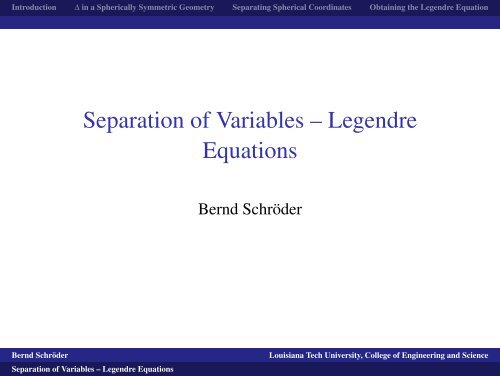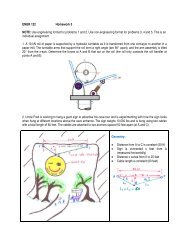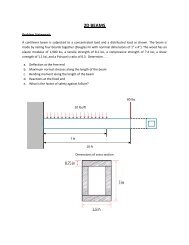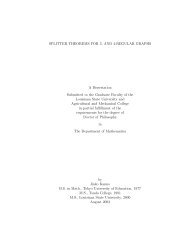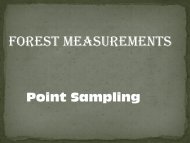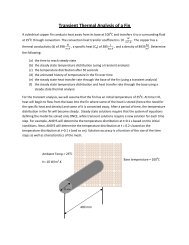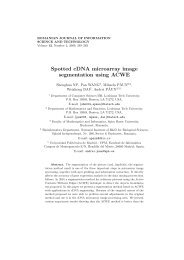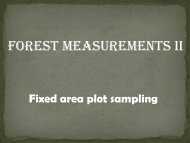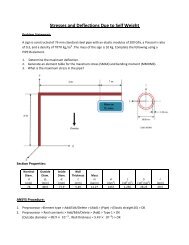Separation of Variables -- Legendre Equations - Louisiana Tech ...
Separation of Variables -- Legendre Equations - Louisiana Tech ...
Separation of Variables -- Legendre Equations - Louisiana Tech ...
Create successful ePaper yourself
Turn your PDF publications into a flip-book with our unique Google optimized e-Paper software.
Introduction ∆ in a Spherically Symmetric Geometry Separating Spherical Coordinates Obtaining the <strong>Legendre</strong> Equation<br />
<strong>Separation</strong> <strong>of</strong> <strong>Variables</strong> – <strong>Legendre</strong><br />
<strong>Equations</strong><br />
Bernd Schröder<br />
logo1<br />
Bernd Schröder <strong>Louisiana</strong> <strong>Tech</strong> University, College <strong>of</strong> Engineering and Science<br />
<strong>Separation</strong> <strong>of</strong> <strong>Variables</strong> – <strong>Legendre</strong> <strong>Equations</strong>
Introduction ∆ in a Spherically Symmetric Geometry Separating Spherical Coordinates Obtaining the <strong>Legendre</strong> Equation<br />
<strong>Separation</strong> <strong>of</strong> <strong>Variables</strong><br />
1. Solution technique for partial differential equations.<br />
logo1<br />
Bernd Schröder <strong>Louisiana</strong> <strong>Tech</strong> University, College <strong>of</strong> Engineering and Science<br />
<strong>Separation</strong> <strong>of</strong> <strong>Variables</strong> – <strong>Legendre</strong> <strong>Equations</strong>
Introduction ∆ in a Spherically Symmetric Geometry Separating Spherical Coordinates Obtaining the <strong>Legendre</strong> Equation<br />
<strong>Separation</strong> <strong>of</strong> <strong>Variables</strong><br />
1. Solution technique for partial differential equations.<br />
2. If the unknown function u depends on variables ρ,θ,φ, we<br />
assume there is a solution <strong>of</strong> the form u = R(ρ)T(θ)P(φ).<br />
logo1<br />
Bernd Schröder <strong>Louisiana</strong> <strong>Tech</strong> University, College <strong>of</strong> Engineering and Science<br />
<strong>Separation</strong> <strong>of</strong> <strong>Variables</strong> – <strong>Legendre</strong> <strong>Equations</strong>
Introduction ∆ in a Spherically Symmetric Geometry Separating Spherical Coordinates Obtaining the <strong>Legendre</strong> Equation<br />
<strong>Separation</strong> <strong>of</strong> <strong>Variables</strong><br />
1. Solution technique for partial differential equations.<br />
2. If the unknown function u depends on variables ρ,θ,φ, we<br />
assume there is a solution <strong>of</strong> the form u = R(ρ)T(θ)P(φ).<br />
3. The special form <strong>of</strong> this solution function allows us to<br />
replace the original partial differential equation with<br />
several ordinary differential equations.<br />
logo1<br />
Bernd Schröder <strong>Louisiana</strong> <strong>Tech</strong> University, College <strong>of</strong> Engineering and Science<br />
<strong>Separation</strong> <strong>of</strong> <strong>Variables</strong> – <strong>Legendre</strong> <strong>Equations</strong>
Introduction ∆ in a Spherically Symmetric Geometry Separating Spherical Coordinates Obtaining the <strong>Legendre</strong> Equation<br />
<strong>Separation</strong> <strong>of</strong> <strong>Variables</strong><br />
1. Solution technique for partial differential equations.<br />
2. If the unknown function u depends on variables ρ,θ,φ, we<br />
assume there is a solution <strong>of</strong> the form u = R(ρ)T(θ)P(φ).<br />
3. The special form <strong>of</strong> this solution function allows us to<br />
replace the original partial differential equation with<br />
several ordinary differential equations.<br />
4. Key step: If f (ρ) = g(θ,φ), then f and g must be constant.<br />
logo1<br />
Bernd Schröder <strong>Louisiana</strong> <strong>Tech</strong> University, College <strong>of</strong> Engineering and Science<br />
<strong>Separation</strong> <strong>of</strong> <strong>Variables</strong> – <strong>Legendre</strong> <strong>Equations</strong>
Introduction ∆ in a Spherically Symmetric Geometry Separating Spherical Coordinates Obtaining the <strong>Legendre</strong> Equation<br />
<strong>Separation</strong> <strong>of</strong> <strong>Variables</strong><br />
1. Solution technique for partial differential equations.<br />
2. If the unknown function u depends on variables ρ,θ,φ, we<br />
assume there is a solution <strong>of</strong> the form u = R(ρ)T(θ)P(φ).<br />
3. The special form <strong>of</strong> this solution function allows us to<br />
replace the original partial differential equation with<br />
several ordinary differential equations.<br />
4. Key step: If f (ρ) = g(θ,φ), then f and g must be constant.<br />
5. Solutions <strong>of</strong> the ordinary differential equations we obtain<br />
must typically be processed some more to give useful<br />
results for the partial differential equations.<br />
logo1<br />
Bernd Schröder <strong>Louisiana</strong> <strong>Tech</strong> University, College <strong>of</strong> Engineering and Science<br />
<strong>Separation</strong> <strong>of</strong> <strong>Variables</strong> – <strong>Legendre</strong> <strong>Equations</strong>
Introduction ∆ in a Spherically Symmetric Geometry Separating Spherical Coordinates Obtaining the <strong>Legendre</strong> Equation<br />
<strong>Separation</strong> <strong>of</strong> <strong>Variables</strong><br />
1. Solution technique for partial differential equations.<br />
2. If the unknown function u depends on variables ρ,θ,φ, we<br />
assume there is a solution <strong>of</strong> the form u = R(ρ)T(θ)P(φ).<br />
3. The special form <strong>of</strong> this solution function allows us to<br />
replace the original partial differential equation with<br />
several ordinary differential equations.<br />
4. Key step: If f (ρ) = g(θ,φ), then f and g must be constant.<br />
5. Solutions <strong>of</strong> the ordinary differential equations we obtain<br />
must typically be processed some more to give useful<br />
results for the partial differential equations.<br />
6. Some very powerful and deep theorems can be used to<br />
formally justify the approach for many equations involving<br />
the Laplace operator.<br />
logo1<br />
Bernd Schröder <strong>Louisiana</strong> <strong>Tech</strong> University, College <strong>of</strong> Engineering and Science<br />
<strong>Separation</strong> <strong>of</strong> <strong>Variables</strong> – <strong>Legendre</strong> <strong>Equations</strong>
Introduction ∆ in a Spherically Symmetric Geometry Separating Spherical Coordinates Obtaining the <strong>Legendre</strong> Equation<br />
How Deep?<br />
logo1<br />
Bernd Schröder <strong>Louisiana</strong> <strong>Tech</strong> University, College <strong>of</strong> Engineering and Science<br />
<strong>Separation</strong> <strong>of</strong> <strong>Variables</strong> – <strong>Legendre</strong> <strong>Equations</strong>
Introduction ∆ in a Spherically Symmetric Geometry Separating Spherical Coordinates Obtaining the <strong>Legendre</strong> Equation<br />
How Deep?<br />
plus about 200 pages <strong>of</strong> really<br />
awesome functional analysis.<br />
logo1<br />
Bernd Schröder <strong>Louisiana</strong> <strong>Tech</strong> University, College <strong>of</strong> Engineering and Science<br />
<strong>Separation</strong> <strong>of</strong> <strong>Variables</strong> – <strong>Legendre</strong> <strong>Equations</strong>
Introduction ∆ in a Spherically Symmetric Geometry Separating Spherical Coordinates Obtaining the <strong>Legendre</strong> Equation<br />
The Equation ∆u = f (ρ)u<br />
logo1<br />
Bernd Schröder <strong>Louisiana</strong> <strong>Tech</strong> University, College <strong>of</strong> Engineering and Science<br />
<strong>Separation</strong> <strong>of</strong> <strong>Variables</strong> – <strong>Legendre</strong> <strong>Equations</strong>
Introduction ∆ in a Spherically Symmetric Geometry Separating Spherical Coordinates Obtaining the <strong>Legendre</strong> Equation<br />
The Equation ∆u = f (ρ)u<br />
1. For constant f , this is an eigenvalue equation for the<br />
Laplace operator, which arises, for example, in separation<br />
<strong>of</strong> variables for the heat equation or the wave equation.<br />
logo1<br />
Bernd Schröder <strong>Louisiana</strong> <strong>Tech</strong> University, College <strong>of</strong> Engineering and Science<br />
<strong>Separation</strong> <strong>of</strong> <strong>Variables</strong> – <strong>Legendre</strong> <strong>Equations</strong>
Introduction ∆ in a Spherically Symmetric Geometry Separating Spherical Coordinates Obtaining the <strong>Legendre</strong> Equation<br />
The Equation ∆u = f (ρ)u<br />
1. For constant f , this is an eigenvalue equation for the<br />
Laplace operator, which arises, for example, in separation<br />
<strong>of</strong> variables for the heat equation or the wave equation.<br />
2. The time independent Schrödinger equation<br />
− ¯h<br />
∆φ + Vφ = Eφ describes certain quantum<br />
2m<br />
mechanical systems, for example, the electron in a<br />
hydrogen atom. m is the mass <strong>of</strong> the electron, ¯h = h<br />
2π ,<br />
where h is Planck’s constant, V(ρ) is the electric potential<br />
and E is the energy eigenvalue.<br />
logo1<br />
Bernd Schröder <strong>Louisiana</strong> <strong>Tech</strong> University, College <strong>of</strong> Engineering and Science<br />
<strong>Separation</strong> <strong>of</strong> <strong>Variables</strong> – <strong>Legendre</strong> <strong>Equations</strong>
Introduction ∆ in a Spherically Symmetric Geometry Separating Spherical Coordinates Obtaining the <strong>Legendre</strong> Equation<br />
The Equation ∆u = f (ρ)u<br />
1. For constant f , this is an eigenvalue equation for the<br />
Laplace operator, which arises, for example, in separation<br />
<strong>of</strong> variables for the heat equation or the wave equation.<br />
2. The time independent Schrödinger equation<br />
− ¯h<br />
∆φ + Vφ = Eφ describes certain quantum<br />
2m<br />
mechanical systems, for example, the electron in a<br />
hydrogen atom. m is the mass <strong>of</strong> the electron, ¯h = h<br />
2π ,<br />
where h is Planck’s constant, V(ρ) is the electric potential<br />
and E is the energy eigenvalue.<br />
3. The equation ∆u = f (ρ)u had already been investigated in<br />
electrodynamics when its importance for the states <strong>of</strong> an<br />
electron in a hydrogen atom became clear.<br />
logo1<br />
Bernd Schröder <strong>Louisiana</strong> <strong>Tech</strong> University, College <strong>of</strong> Engineering and Science<br />
<strong>Separation</strong> <strong>of</strong> <strong>Variables</strong> – <strong>Legendre</strong> <strong>Equations</strong>
Introduction ∆ in a Spherically Symmetric Geometry Separating Spherical Coordinates Obtaining the <strong>Legendre</strong> Equation<br />
Separating the Equation ∆u = f (ρ)u (Radial Part)<br />
logo1<br />
Bernd Schröder <strong>Louisiana</strong> <strong>Tech</strong> University, College <strong>of</strong> Engineering and Science<br />
<strong>Separation</strong> <strong>of</strong> <strong>Variables</strong> – <strong>Legendre</strong> <strong>Equations</strong>
Introduction ∆ in a Spherically Symmetric Geometry Separating Spherical Coordinates Obtaining the <strong>Legendre</strong> Equation<br />
Separating the Equation ∆u = f (ρ)u (Radial Part)<br />
∂ 2u 2 ∂u 1<br />
+ +<br />
∂ρ 2 ρ ∂ρ ρ2 ∂ 2u cos(φ)<br />
+<br />
∂φ 2 ρ2 sin(φ)<br />
∂u<br />
∂φ +<br />
1<br />
ρ2 sin 2 ∂<br />
(φ)<br />
2u = f (ρ)u<br />
∂θ 2<br />
logo1<br />
Bernd Schröder <strong>Louisiana</strong> <strong>Tech</strong> University, College <strong>of</strong> Engineering and Science<br />
<strong>Separation</strong> <strong>of</strong> <strong>Variables</strong> – <strong>Legendre</strong> <strong>Equations</strong>
Introduction ∆ in a Spherically Symmetric Geometry Separating Spherical Coordinates Obtaining the <strong>Legendre</strong> Equation<br />
Separating the Equation ∆u = f (ρ)u (Radial Part)<br />
R ′′ TP<br />
∂ 2u 2 ∂u 1<br />
+ +<br />
∂ρ 2 ρ ∂ρ ρ2 ∂ 2u cos(φ)<br />
+<br />
∂φ 2 ρ2 sin(φ)<br />
∂u<br />
∂φ +<br />
1<br />
ρ2 sin 2 ∂<br />
(φ)<br />
2u = f (ρ)u<br />
∂θ 2<br />
logo1<br />
Bernd Schröder <strong>Louisiana</strong> <strong>Tech</strong> University, College <strong>of</strong> Engineering and Science<br />
<strong>Separation</strong> <strong>of</strong> <strong>Variables</strong> – <strong>Legendre</strong> <strong>Equations</strong>
Introduction ∆ in a Spherically Symmetric Geometry Separating Spherical Coordinates Obtaining the <strong>Legendre</strong> Equation<br />
Separating the Equation ∆u = f (ρ)u (Radial Part)<br />
∂ 2u 2 ∂u 1<br />
+ +<br />
∂ρ 2 ρ ∂ρ ρ2 ∂ 2u cos(φ)<br />
+<br />
∂φ 2 ρ2 sin(φ)<br />
R ′′ TP + 2<br />
ρ R′ TP<br />
∂u<br />
∂φ +<br />
1<br />
ρ2 sin 2 ∂<br />
(φ)<br />
2u = f (ρ)u<br />
∂θ 2<br />
logo1<br />
Bernd Schröder <strong>Louisiana</strong> <strong>Tech</strong> University, College <strong>of</strong> Engineering and Science<br />
<strong>Separation</strong> <strong>of</strong> <strong>Variables</strong> – <strong>Legendre</strong> <strong>Equations</strong>
Introduction ∆ in a Spherically Symmetric Geometry Separating Spherical Coordinates Obtaining the <strong>Legendre</strong> Equation<br />
Separating the Equation ∆u = f (ρ)u (Radial Part)<br />
∂ 2u 2 ∂u 1<br />
+ +<br />
∂ρ 2 ρ ∂ρ ρ2 ∂ 2u cos(φ)<br />
+<br />
∂φ 2 ρ2 sin(φ)<br />
R ′′ TP + 2<br />
ρ R′ TP + 1<br />
ρ<br />
2 RTP′′<br />
∂u<br />
∂φ +<br />
1<br />
ρ2 sin 2 ∂<br />
(φ)<br />
2u = f (ρ)u<br />
∂θ 2<br />
logo1<br />
Bernd Schröder <strong>Louisiana</strong> <strong>Tech</strong> University, College <strong>of</strong> Engineering and Science<br />
<strong>Separation</strong> <strong>of</strong> <strong>Variables</strong> – <strong>Legendre</strong> <strong>Equations</strong>
Introduction ∆ in a Spherically Symmetric Geometry Separating Spherical Coordinates Obtaining the <strong>Legendre</strong> Equation<br />
Separating the Equation ∆u = f (ρ)u (Radial Part)<br />
∂ 2u 2 ∂u 1<br />
+ +<br />
∂ρ 2 ρ ∂ρ ρ2 ∂ 2u cos(φ)<br />
+<br />
∂φ 2 ρ2 sin(φ)<br />
R ′′ TP + 2<br />
ρ R′ TP + 1<br />
ρ 2 RTP′′ + cos(φ)<br />
ρ 2 sin(φ) RTP′<br />
∂u<br />
∂φ +<br />
1<br />
ρ2 sin 2 ∂<br />
(φ)<br />
2u = f (ρ)u<br />
∂θ 2<br />
logo1<br />
Bernd Schröder <strong>Louisiana</strong> <strong>Tech</strong> University, College <strong>of</strong> Engineering and Science<br />
<strong>Separation</strong> <strong>of</strong> <strong>Variables</strong> – <strong>Legendre</strong> <strong>Equations</strong>
Introduction ∆ in a Spherically Symmetric Geometry Separating Spherical Coordinates Obtaining the <strong>Legendre</strong> Equation<br />
Separating the Equation ∆u = f (ρ)u (Radial Part)<br />
∂ 2u 2 ∂u 1<br />
+ +<br />
∂ρ 2 ρ ∂ρ ρ2 ∂ 2u cos(φ)<br />
+<br />
∂φ 2 ρ2 sin(φ)<br />
R ′′ TP + 2<br />
ρ R′ TP + 1<br />
ρ 2 RTP′′ + cos(φ)<br />
ρ 2 sin(φ) RTP′ +<br />
∂u<br />
∂φ +<br />
1<br />
ρ2 sin 2 ∂<br />
(φ)<br />
2u ∂θ 2<br />
1<br />
ρ<br />
= f (ρ)u<br />
2 sin 2 (φ) RT′′ P<br />
logo1<br />
Bernd Schröder <strong>Louisiana</strong> <strong>Tech</strong> University, College <strong>of</strong> Engineering and Science<br />
<strong>Separation</strong> <strong>of</strong> <strong>Variables</strong> – <strong>Legendre</strong> <strong>Equations</strong>
Introduction ∆ in a Spherically Symmetric Geometry Separating Spherical Coordinates Obtaining the <strong>Legendre</strong> Equation<br />
Separating the Equation ∆u = f (ρ)u (Radial Part)<br />
∂ 2u 2 ∂u 1<br />
+ +<br />
∂ρ 2 ρ ∂ρ ρ2 ∂ 2u cos(φ)<br />
+<br />
∂φ 2 ρ2 sin(φ)<br />
R ′′ TP + 2<br />
ρ R′ TP + 1<br />
ρ 2 RTP′′ + cos(φ)<br />
ρ 2 sin(φ) RTP′ +<br />
∂u<br />
∂φ +<br />
1<br />
ρ2 sin 2 ∂<br />
(φ)<br />
2u ∂θ 2 = f (ρ)u<br />
1<br />
ρ2 sin 2 (φ) RT′′ P = f (ρ)RTP<br />
logo1<br />
Bernd Schröder <strong>Louisiana</strong> <strong>Tech</strong> University, College <strong>of</strong> Engineering and Science<br />
<strong>Separation</strong> <strong>of</strong> <strong>Variables</strong> – <strong>Legendre</strong> <strong>Equations</strong>
Introduction ∆ in a Spherically Symmetric Geometry Separating Spherical Coordinates Obtaining the <strong>Legendre</strong> Equation<br />
Separating the Equation ∆u = f (ρ)u (Radial Part)<br />
∂ 2u 2 ∂u 1<br />
+ +<br />
∂ρ 2 ρ ∂ρ ρ2 ∂ 2u cos(φ)<br />
+<br />
∂φ 2 ρ2 sin(φ)<br />
R ′′ TP + 2<br />
ρ R′ TP + 1<br />
ρ 2 RTP′′ + cos(φ)<br />
ρ 2 sin(φ) RTP′ +<br />
2 R′′<br />
ρ<br />
R<br />
∂u<br />
∂φ +<br />
1<br />
ρ2 sin 2 ∂<br />
(φ)<br />
2u ∂θ 2 = f (ρ)u<br />
1<br />
ρ2 sin 2 (φ) RT′′ P = f (ρ)RTP<br />
logo1<br />
Bernd Schröder <strong>Louisiana</strong> <strong>Tech</strong> University, College <strong>of</strong> Engineering and Science<br />
<strong>Separation</strong> <strong>of</strong> <strong>Variables</strong> – <strong>Legendre</strong> <strong>Equations</strong>
Introduction ∆ in a Spherically Symmetric Geometry Separating Spherical Coordinates Obtaining the <strong>Legendre</strong> Equation<br />
Separating the Equation ∆u = f (ρ)u (Radial Part)<br />
∂ 2u 2 ∂u 1<br />
+ +<br />
∂ρ 2 ρ ∂ρ ρ2 ∂ 2u cos(φ)<br />
+<br />
∂φ 2 ρ2 sin(φ)<br />
R ′′ TP + 2<br />
ρ R′ TP + 1<br />
ρ 2 RTP′′ + cos(φ)<br />
ρ 2 sin(φ) RTP′ +<br />
2 R′′ R′<br />
ρ + 2ρ<br />
R R<br />
∂u<br />
∂φ +<br />
1<br />
ρ2 sin 2 ∂<br />
(φ)<br />
2u ∂θ 2 = f (ρ)u<br />
1<br />
ρ2 sin 2 (φ) RT′′ P = f (ρ)RTP<br />
logo1<br />
Bernd Schröder <strong>Louisiana</strong> <strong>Tech</strong> University, College <strong>of</strong> Engineering and Science<br />
<strong>Separation</strong> <strong>of</strong> <strong>Variables</strong> – <strong>Legendre</strong> <strong>Equations</strong>
Introduction ∆ in a Spherically Symmetric Geometry Separating Spherical Coordinates Obtaining the <strong>Legendre</strong> Equation<br />
Separating the Equation ∆u = f (ρ)u (Radial Part)<br />
∂ 2u 2 ∂u 1<br />
+ +<br />
∂ρ 2 ρ ∂ρ ρ2 ∂ 2u cos(φ)<br />
+<br />
∂φ 2 ρ2 sin(φ)<br />
R ′′ TP + 2<br />
ρ R′ TP + 1<br />
ρ 2 RTP′′ + cos(φ)<br />
ρ 2 sin(φ) RTP′ +<br />
2 R′′ R′ P′′<br />
ρ + 2ρ +<br />
R R P<br />
∂u<br />
∂φ +<br />
1<br />
ρ2 sin 2 ∂<br />
(φ)<br />
2u ∂θ 2 = f (ρ)u<br />
1<br />
ρ2 sin 2 (φ) RT′′ P = f (ρ)RTP<br />
logo1<br />
Bernd Schröder <strong>Louisiana</strong> <strong>Tech</strong> University, College <strong>of</strong> Engineering and Science<br />
<strong>Separation</strong> <strong>of</strong> <strong>Variables</strong> – <strong>Legendre</strong> <strong>Equations</strong>
Introduction ∆ in a Spherically Symmetric Geometry Separating Spherical Coordinates Obtaining the <strong>Legendre</strong> Equation<br />
Separating the Equation ∆u = f (ρ)u (Radial Part)<br />
∂ 2u 2 ∂u 1<br />
+ +<br />
∂ρ 2 ρ ∂ρ ρ2 ∂ 2u cos(φ)<br />
+<br />
∂φ 2 ρ2 sin(φ)<br />
R ′′ TP + 2<br />
ρ R′ TP + 1<br />
ρ 2 RTP′′ + cos(φ)<br />
ρ 2 sin(φ) RTP′ +<br />
2 R′′ R′ P′′<br />
ρ + 2ρ +<br />
R R P<br />
∂u<br />
∂φ +<br />
1<br />
ρ2 sin 2 ∂<br />
(φ)<br />
2u ∂θ 2 = f (ρ)u<br />
1<br />
ρ2 sin 2 (φ) RT′′ P = f (ρ)RTP<br />
+ cos(φ)<br />
sin(φ)<br />
logo1<br />
Bernd Schröder <strong>Louisiana</strong> <strong>Tech</strong> University, College <strong>of</strong> Engineering and Science<br />
<strong>Separation</strong> <strong>of</strong> <strong>Variables</strong> – <strong>Legendre</strong> <strong>Equations</strong><br />
P ′<br />
P
Introduction ∆ in a Spherically Symmetric Geometry Separating Spherical Coordinates Obtaining the <strong>Legendre</strong> Equation<br />
Separating the Equation ∆u = f (ρ)u (Radial Part)<br />
∂ 2u 2 ∂u 1<br />
+ +<br />
∂ρ 2 ρ ∂ρ ρ2 ∂ 2u cos(φ)<br />
+<br />
∂φ 2 ρ2 sin(φ)<br />
R ′′ TP + 2<br />
ρ R′ TP + 1<br />
ρ 2 RTP′′ + cos(φ)<br />
ρ 2 sin(φ) RTP′ +<br />
2 R′′ R′ P′′<br />
ρ + 2ρ +<br />
R R P<br />
∂u<br />
∂φ +<br />
1<br />
ρ2 sin 2 ∂<br />
(φ)<br />
2u ∂θ 2 = f (ρ)u<br />
1<br />
ρ2 sin 2 (φ) RT′′ P = f (ρ)RTP<br />
+ cos(φ)<br />
sin(φ)<br />
P ′ 1<br />
+<br />
P sin2 (φ)<br />
logo1<br />
Bernd Schröder <strong>Louisiana</strong> <strong>Tech</strong> University, College <strong>of</strong> Engineering and Science<br />
<strong>Separation</strong> <strong>of</strong> <strong>Variables</strong> – <strong>Legendre</strong> <strong>Equations</strong><br />
T ′′<br />
T
Introduction ∆ in a Spherically Symmetric Geometry Separating Spherical Coordinates Obtaining the <strong>Legendre</strong> Equation<br />
Separating the Equation ∆u = f (ρ)u (Radial Part)<br />
∂ 2u 2 ∂u 1<br />
+ +<br />
∂ρ 2 ρ ∂ρ ρ2 ∂ 2u cos(φ)<br />
+<br />
∂φ 2 ρ2 sin(φ)<br />
R ′′ TP + 2<br />
ρ R′ TP + 1<br />
ρ 2 RTP′′ + cos(φ)<br />
ρ 2 sin(φ) RTP′ +<br />
2 R′′ R′ P′′<br />
ρ + 2ρ +<br />
R R P<br />
∂u<br />
∂φ +<br />
1<br />
ρ2 sin 2 ∂<br />
(φ)<br />
2u ∂θ 2 = f (ρ)u<br />
1<br />
ρ2 sin 2 (φ) RT′′ P = f (ρ)RTP<br />
+ cos(φ)<br />
sin(φ)<br />
P ′ 1<br />
+<br />
P sin2 (φ)<br />
T ′′<br />
T = ρ2 f (ρ)<br />
logo1<br />
Bernd Schröder <strong>Louisiana</strong> <strong>Tech</strong> University, College <strong>of</strong> Engineering and Science<br />
<strong>Separation</strong> <strong>of</strong> <strong>Variables</strong> – <strong>Legendre</strong> <strong>Equations</strong>
Introduction ∆ in a Spherically Symmetric Geometry Separating Spherical Coordinates Obtaining the <strong>Legendre</strong> Equation<br />
Separating the Equation ∆u = f (ρ)u (Radial Part)<br />
∂ 2u 2 ∂u 1<br />
+ +<br />
∂ρ 2 ρ ∂ρ ρ2 ∂ 2u cos(φ)<br />
+<br />
∂φ 2 ρ2 sin(φ)<br />
R ′′ TP + 2<br />
ρ R′ TP + 1<br />
ρ 2 RTP′′ + cos(φ)<br />
ρ 2 sin(φ) RTP′ +<br />
2 R′′ R′ P′′<br />
ρ + 2ρ +<br />
R R P<br />
∂u<br />
∂φ +<br />
1<br />
ρ2 sin 2 ∂<br />
(φ)<br />
2u ∂θ 2 = f (ρ)u<br />
1<br />
ρ2 sin 2 (φ) RT′′ P = f (ρ)RTP<br />
+ cos(φ)<br />
sin(φ)<br />
P ′ 1<br />
+<br />
P sin2 (φ)<br />
Bring all terms that depend on ρ to the right side:<br />
T ′′<br />
T = ρ2 f (ρ)<br />
logo1<br />
Bernd Schröder <strong>Louisiana</strong> <strong>Tech</strong> University, College <strong>of</strong> Engineering and Science<br />
<strong>Separation</strong> <strong>of</strong> <strong>Variables</strong> – <strong>Legendre</strong> <strong>Equations</strong>
Introduction ∆ in a Spherically Symmetric Geometry Separating Spherical Coordinates Obtaining the <strong>Legendre</strong> Equation<br />
Separating the Equation ∆u = f (ρ)u (Radial Part)<br />
∂ 2u 2 ∂u 1<br />
+ +<br />
∂ρ 2 ρ ∂ρ ρ2 ∂ 2u cos(φ)<br />
+<br />
∂φ 2 ρ2 sin(φ)<br />
R ′′ TP + 2<br />
ρ R′ TP + 1<br />
ρ 2 RTP′′ + cos(φ)<br />
ρ 2 sin(φ) RTP′ +<br />
2 R′′ R′ P′′<br />
ρ + 2ρ +<br />
R R P<br />
∂u<br />
∂φ +<br />
1<br />
ρ2 sin 2 ∂<br />
(φ)<br />
2u ∂θ 2 = f (ρ)u<br />
1<br />
ρ2 sin 2 (φ) RT′′ P = f (ρ)RTP<br />
+ cos(φ)<br />
sin(φ)<br />
P ′ 1<br />
+<br />
P sin2 (φ)<br />
Bring all terms that depend on ρ to the right side:<br />
P ′′<br />
P<br />
T ′′<br />
T = ρ2 f (ρ)<br />
cos(φ) P<br />
+<br />
sin(φ)<br />
′ 1<br />
+<br />
P sin 2 T<br />
(φ)<br />
′′<br />
T = ρ2 2 R′′ R′<br />
f (ρ) − ρ − 2ρ<br />
R R ,<br />
logo1<br />
Bernd Schröder <strong>Louisiana</strong> <strong>Tech</strong> University, College <strong>of</strong> Engineering and Science<br />
<strong>Separation</strong> <strong>of</strong> <strong>Variables</strong> – <strong>Legendre</strong> <strong>Equations</strong>
Introduction ∆ in a Spherically Symmetric Geometry Separating Spherical Coordinates Obtaining the <strong>Legendre</strong> Equation<br />
Separating the Equation ∆u = f (ρ)u (Radial Part)<br />
∂ 2u 2 ∂u 1<br />
+ +<br />
∂ρ 2 ρ ∂ρ ρ2 ∂ 2u cos(φ)<br />
+<br />
∂φ 2 ρ2 sin(φ)<br />
R ′′ TP + 2<br />
ρ R′ TP + 1<br />
ρ 2 RTP′′ + cos(φ)<br />
ρ 2 sin(φ) RTP′ +<br />
2 R′′ R′ P′′<br />
ρ + 2ρ +<br />
R R P<br />
∂u<br />
∂φ +<br />
1<br />
ρ2 sin 2 ∂<br />
(φ)<br />
2u ∂θ 2 = f (ρ)u<br />
1<br />
ρ2 sin 2 (φ) RT′′ P = f (ρ)RTP<br />
+ cos(φ)<br />
sin(φ)<br />
P ′ 1<br />
+<br />
P sin2 (φ)<br />
Bring all terms that depend on ρ to the right side:<br />
P ′′<br />
P<br />
cos(φ) P<br />
+<br />
sin(φ)<br />
′ 1<br />
+<br />
P<br />
sin 2 (φ)<br />
Both sides must be constant.<br />
T ′′<br />
T = ρ2 f (ρ)<br />
T ′′<br />
T = ρ2 2 R′′ R′<br />
f (ρ) − ρ − 2ρ<br />
R R ,<br />
logo1<br />
Bernd Schröder <strong>Louisiana</strong> <strong>Tech</strong> University, College <strong>of</strong> Engineering and Science<br />
<strong>Separation</strong> <strong>of</strong> <strong>Variables</strong> – <strong>Legendre</strong> <strong>Equations</strong>
Introduction ∆ in a Spherically Symmetric Geometry Separating Spherical Coordinates Obtaining the <strong>Legendre</strong> Equation<br />
Separating the Equation ∆u = f (ρ)u (Radial Part)<br />
∂ 2u 2 ∂u 1<br />
+ +<br />
∂ρ 2 ρ ∂ρ ρ2 ∂ 2u cos(φ)<br />
+<br />
∂φ 2 ρ2 sin(φ)<br />
R ′′ TP + 2<br />
ρ R′ TP + 1<br />
ρ 2 RTP′′ + cos(φ)<br />
ρ 2 sin(φ) RTP′ +<br />
2 R′′ R′ P′′<br />
ρ + 2ρ +<br />
R R P<br />
∂u<br />
∂φ +<br />
1<br />
ρ2 sin 2 ∂<br />
(φ)<br />
2u ∂θ 2 = f (ρ)u<br />
1<br />
ρ2 sin 2 (φ) RT′′ P = f (ρ)RTP<br />
+ cos(φ)<br />
sin(φ)<br />
P ′ 1<br />
+<br />
P sin2 (φ)<br />
Bring all terms that depend on ρ to the right side:<br />
P ′′<br />
P<br />
cos(φ) P<br />
+<br />
sin(φ)<br />
′ 1<br />
+<br />
P<br />
sin 2 (φ)<br />
Both sides must be constant.<br />
ρ 2 2 R′′ R′<br />
f (ρ) − ρ − 2ρ = −λ, or<br />
R R<br />
T ′′<br />
T = ρ2 f (ρ)<br />
T ′′<br />
T = ρ2 2 R′′ R′<br />
f (ρ) − ρ − 2ρ<br />
R R ,<br />
logo1<br />
Bernd Schröder <strong>Louisiana</strong> <strong>Tech</strong> University, College <strong>of</strong> Engineering and Science<br />
<strong>Separation</strong> <strong>of</strong> <strong>Variables</strong> – <strong>Legendre</strong> <strong>Equations</strong>
Introduction ∆ in a Spherically Symmetric Geometry Separating Spherical Coordinates Obtaining the <strong>Legendre</strong> Equation<br />
Separating the Equation ∆u = f (ρ)u (Radial Part)<br />
∂ 2u 2 ∂u 1<br />
+ +<br />
∂ρ 2 ρ ∂ρ ρ2 ∂ 2u cos(φ)<br />
+<br />
∂φ 2 ρ2 sin(φ)<br />
R ′′ TP + 2<br />
ρ R′ TP + 1<br />
ρ 2 RTP′′ + cos(φ)<br />
ρ 2 sin(φ) RTP′ +<br />
2 R′′ R′ P′′<br />
ρ + 2ρ +<br />
R R P<br />
∂u<br />
∂φ +<br />
1<br />
ρ2 sin 2 ∂<br />
(φ)<br />
2u ∂θ 2 = f (ρ)u<br />
1<br />
ρ2 sin 2 (φ) RT′′ P = f (ρ)RTP<br />
+ cos(φ)<br />
sin(φ)<br />
P ′ 1<br />
+<br />
P sin2 (φ)<br />
Bring all terms that depend on ρ to the right side:<br />
T ′′<br />
T = ρ2 f (ρ)<br />
P ′′ cos(φ) P<br />
+<br />
P sin(φ)<br />
′ 1<br />
+<br />
P sin 2 T<br />
(φ)<br />
′′<br />
T = ρ2 2 R′′ R′<br />
f (ρ) − ρ − 2ρ<br />
R R ,<br />
Both sides must be constant.<br />
ρ 2 2 R′′ R′<br />
f (ρ) − ρ − 2ρ = −λ, or<br />
R R<br />
ρ 2 R ′′ + 2ρR ′ − λR + ρ 2 f (ρ) R = 0.<br />
logo1<br />
Bernd Schröder <strong>Louisiana</strong> <strong>Tech</strong> University, College <strong>of</strong> Engineering and Science<br />
<strong>Separation</strong> <strong>of</strong> <strong>Variables</strong> – <strong>Legendre</strong> <strong>Equations</strong>
Introduction ∆ in a Spherically Symmetric Geometry Separating Spherical Coordinates Obtaining the <strong>Legendre</strong> Equation<br />
Separating the Equation ∆u = f (ρ)u (Radial Part)<br />
∂ 2u 2 ∂u 1<br />
+ +<br />
∂ρ 2 ρ ∂ρ ρ2 ∂ 2u cos(φ)<br />
+<br />
∂φ 2 ρ2 sin(φ)<br />
R ′′ TP + 2<br />
ρ R′ TP + 1<br />
ρ 2 RTP′′ + cos(φ)<br />
ρ 2 sin(φ) RTP′ +<br />
2 R′′ R′ P′′<br />
ρ + 2ρ +<br />
R R P<br />
∂u<br />
∂φ +<br />
1<br />
ρ2 sin 2 ∂<br />
(φ)<br />
2u ∂θ 2 = f (ρ)u<br />
1<br />
ρ2 sin 2 (φ) RT′′ P = f (ρ)RTP<br />
+ cos(φ)<br />
sin(φ)<br />
P ′ 1<br />
+<br />
P sin2 (φ)<br />
Bring all terms that depend on ρ to the right side:<br />
T ′′<br />
T = ρ2 f (ρ)<br />
P ′′ cos(φ) P<br />
+<br />
P sin(φ)<br />
′ 1<br />
+<br />
P sin 2 T<br />
(φ)<br />
′′<br />
T = ρ2 2 R′′ R′<br />
f (ρ) − ρ − 2ρ<br />
R R ,<br />
Both sides must be constant.<br />
ρ 2 2 R′′ R′<br />
f (ρ) − ρ − 2ρ = −λ, or<br />
R R<br />
ρ 2 R ′′ + 2ρR ′ − λR + ρ 2 f (ρ) R = 0. (QM: Laguerre polys.)<br />
logo1<br />
Bernd Schröder <strong>Louisiana</strong> <strong>Tech</strong> University, College <strong>of</strong> Engineering and Science<br />
<strong>Separation</strong> <strong>of</strong> <strong>Variables</strong> – <strong>Legendre</strong> <strong>Equations</strong>
Introduction ∆ in a Spherically Symmetric Geometry Separating Spherical Coordinates Obtaining the <strong>Legendre</strong> Equation<br />
Separating the Equation ∆u = f (ρ)u (Azimuthal Part)<br />
logo1<br />
Bernd Schröder <strong>Louisiana</strong> <strong>Tech</strong> University, College <strong>of</strong> Engineering and Science<br />
<strong>Separation</strong> <strong>of</strong> <strong>Variables</strong> – <strong>Legendre</strong> <strong>Equations</strong>
Introduction ∆ in a Spherically Symmetric Geometry Separating Spherical Coordinates Obtaining the <strong>Legendre</strong> Equation<br />
Separating the Equation ∆u = f (ρ)u (Azimuthal Part)<br />
P ′′<br />
P<br />
cos(φ) P<br />
+<br />
sin(φ)<br />
′ 1<br />
+<br />
P sin2 T<br />
(φ)<br />
′′<br />
T<br />
= −λ<br />
logo1<br />
Bernd Schröder <strong>Louisiana</strong> <strong>Tech</strong> University, College <strong>of</strong> Engineering and Science<br />
<strong>Separation</strong> <strong>of</strong> <strong>Variables</strong> – <strong>Legendre</strong> <strong>Equations</strong>
Introduction ∆ in a Spherically Symmetric Geometry Separating Spherical Coordinates Obtaining the <strong>Legendre</strong> Equation<br />
Separating the Equation ∆u = f (ρ)u (Azimuthal Part)<br />
P ′′<br />
P<br />
sin 2 (φ) P′′<br />
P<br />
cos(φ) P<br />
+<br />
sin(φ)<br />
′ 1<br />
+<br />
P sin2 T<br />
(φ)<br />
′′<br />
T<br />
= −λ<br />
T′′<br />
+ sin(φ)cos(φ)P′ +<br />
P T = −λ sin2 (φ)<br />
logo1<br />
Bernd Schröder <strong>Louisiana</strong> <strong>Tech</strong> University, College <strong>of</strong> Engineering and Science<br />
<strong>Separation</strong> <strong>of</strong> <strong>Variables</strong> – <strong>Legendre</strong> <strong>Equations</strong>
Introduction ∆ in a Spherically Symmetric Geometry Separating Spherical Coordinates Obtaining the <strong>Legendre</strong> Equation<br />
Separating the Equation ∆u = f (ρ)u (Azimuthal Part)<br />
sin 2 (φ) P′′<br />
P<br />
P ′′<br />
P<br />
sin 2 (φ) P′′<br />
P<br />
cos(φ) P<br />
+<br />
sin(φ)<br />
′ 1<br />
+<br />
P sin2 T<br />
(φ)<br />
′′<br />
T<br />
= −λ<br />
T′′<br />
+ sin(φ)cos(φ)P′ +<br />
P T = −λ sin2 (φ)<br />
+ sin(φ)cos(φ)P′<br />
P + λ sin2 (φ) = − T′′<br />
T<br />
logo1<br />
Bernd Schröder <strong>Louisiana</strong> <strong>Tech</strong> University, College <strong>of</strong> Engineering and Science<br />
<strong>Separation</strong> <strong>of</strong> <strong>Variables</strong> – <strong>Legendre</strong> <strong>Equations</strong>
Introduction ∆ in a Spherically Symmetric Geometry Separating Spherical Coordinates Obtaining the <strong>Legendre</strong> Equation<br />
Separating the Equation ∆u = f (ρ)u (Azimuthal Part)<br />
sin 2 (φ) P′′<br />
P ′′<br />
P<br />
sin 2 (φ) P′′<br />
P<br />
cos(φ) P<br />
+<br />
sin(φ)<br />
′ 1<br />
+<br />
P sin2 T<br />
(φ)<br />
′′<br />
T<br />
+ sin(φ)cos(φ)P′<br />
P<br />
Both sides must be constant.<br />
= −λ<br />
T′′<br />
+ sin(φ)cos(φ)P′ +<br />
P T = −λ sin2 (φ)<br />
P + λ sin2 (φ) = − T′′<br />
T<br />
logo1<br />
Bernd Schröder <strong>Louisiana</strong> <strong>Tech</strong> University, College <strong>of</strong> Engineering and Science<br />
<strong>Separation</strong> <strong>of</strong> <strong>Variables</strong> – <strong>Legendre</strong> <strong>Equations</strong>
Introduction ∆ in a Spherically Symmetric Geometry Separating Spherical Coordinates Obtaining the <strong>Legendre</strong> Equation<br />
Separating the Equation ∆u = f (ρ)u (Azimuthal Part)<br />
P ′′<br />
P<br />
sin 2 (φ) P′′<br />
P<br />
cos(φ) P<br />
+<br />
sin(φ)<br />
′ 1<br />
+<br />
P sin2 T<br />
(φ)<br />
′′<br />
T<br />
= −λ<br />
T′′<br />
+ sin(φ)cos(φ)P′ +<br />
P T = −λ sin2 (φ)<br />
sin 2 (φ) P′′<br />
+ sin(φ)cos(φ)P′<br />
P P + λ sin2 (φ) = − T′′<br />
Both sides must be constant.<br />
−<br />
T<br />
T′′<br />
T = c leads to T′′ + cT = 0.<br />
logo1<br />
Bernd Schröder <strong>Louisiana</strong> <strong>Tech</strong> University, College <strong>of</strong> Engineering and Science<br />
<strong>Separation</strong> <strong>of</strong> <strong>Variables</strong> – <strong>Legendre</strong> <strong>Equations</strong>
Introduction ∆ in a Spherically Symmetric Geometry Separating Spherical Coordinates Obtaining the <strong>Legendre</strong> Equation<br />
Separating the Equation ∆u = f (ρ)u (Azimuthal Part)<br />
P ′′<br />
P<br />
sin 2 (φ) P′′<br />
P<br />
cos(φ) P<br />
+<br />
sin(φ)<br />
′ 1<br />
+<br />
P sin2 T<br />
(φ)<br />
′′<br />
T<br />
= −λ<br />
T′′<br />
+ sin(φ)cos(φ)P′ +<br />
P T = −λ sin2 (φ)<br />
sin 2 (φ) P′′<br />
+ sin(φ)cos(φ)P′<br />
P P + λ sin2 (φ) = − T′′<br />
Both sides must be constant.<br />
−<br />
T<br />
T′′<br />
T = c leads to T′′ + cT = 0.<br />
But T must be 2π-periodic.<br />
logo1<br />
Bernd Schröder <strong>Louisiana</strong> <strong>Tech</strong> University, College <strong>of</strong> Engineering and Science<br />
<strong>Separation</strong> <strong>of</strong> <strong>Variables</strong> – <strong>Legendre</strong> <strong>Equations</strong>
Introduction ∆ in a Spherically Symmetric Geometry Separating Spherical Coordinates Obtaining the <strong>Legendre</strong> Equation<br />
Separating the Equation ∆u = f (ρ)u (Azimuthal Part)<br />
P ′′<br />
P<br />
sin 2 (φ) P′′<br />
P<br />
cos(φ) P<br />
+<br />
sin(φ)<br />
′ 1<br />
+<br />
P sin2 T<br />
(φ)<br />
′′<br />
T<br />
= −λ<br />
T′′<br />
+ sin(φ)cos(φ)P′ +<br />
P T = −λ sin2 (φ)<br />
sin 2 (φ) P′′<br />
+ sin(φ)cos(φ)P′<br />
P P + λ sin2 (φ) = − T′′<br />
T<br />
Both sides must be constant.<br />
− T′′<br />
T = c leads to T′′ + cT = 0.<br />
But T must be 2π-periodic. Thus c = m2 , where m is a<br />
nonnegative integer.<br />
logo1<br />
Bernd Schröder <strong>Louisiana</strong> <strong>Tech</strong> University, College <strong>of</strong> Engineering and Science<br />
<strong>Separation</strong> <strong>of</strong> <strong>Variables</strong> – <strong>Legendre</strong> <strong>Equations</strong>
Introduction ∆ in a Spherically Symmetric Geometry Separating Spherical Coordinates Obtaining the <strong>Legendre</strong> Equation<br />
Separating the Equation ∆u = f (ρ)u (Azimuthal Part)<br />
P ′′<br />
P<br />
sin 2 (φ) P′′<br />
P<br />
cos(φ) P<br />
+<br />
sin(φ)<br />
′ 1<br />
+<br />
P sin2 T<br />
(φ)<br />
′′<br />
T<br />
= −λ<br />
T′′<br />
+ sin(φ)cos(φ)P′ +<br />
P T = −λ sin2 (φ)<br />
sin 2 (φ) P′′<br />
+ sin(φ)cos(φ)P′<br />
P P + λ sin2 (φ) = − T′′<br />
T<br />
Both sides must be constant.<br />
− T′′<br />
T = c leads to T′′ + cT = 0.<br />
But T must be 2π-periodic. Thus c = m2 , where m is a<br />
nonnegative integer.<br />
So the function T must be <strong>of</strong> the form<br />
T(θ) = c1 cos(mθ) + c2 sin(mθ).<br />
logo1<br />
Bernd Schröder <strong>Louisiana</strong> <strong>Tech</strong> University, College <strong>of</strong> Engineering and Science<br />
<strong>Separation</strong> <strong>of</strong> <strong>Variables</strong> – <strong>Legendre</strong> <strong>Equations</strong>
Introduction ∆ in a Spherically Symmetric Geometry Separating Spherical Coordinates Obtaining the <strong>Legendre</strong> Equation<br />
Separating the Equation ∆u = f (ρ)u (Polar Part)<br />
logo1<br />
Bernd Schröder <strong>Louisiana</strong> <strong>Tech</strong> University, College <strong>of</strong> Engineering and Science<br />
<strong>Separation</strong> <strong>of</strong> <strong>Variables</strong> – <strong>Legendre</strong> <strong>Equations</strong>
Introduction ∆ in a Spherically Symmetric Geometry Separating Spherical Coordinates Obtaining the <strong>Legendre</strong> Equation<br />
Separating the Equation ∆u = f (ρ)u (Polar Part)<br />
sin 2 (φ) P′′<br />
P<br />
+ sin(φ)cos(φ)P′<br />
P + λ sin2 (φ) = m 2<br />
logo1<br />
Bernd Schröder <strong>Louisiana</strong> <strong>Tech</strong> University, College <strong>of</strong> Engineering and Science<br />
<strong>Separation</strong> <strong>of</strong> <strong>Variables</strong> – <strong>Legendre</strong> <strong>Equations</strong>
Introduction ∆ in a Spherically Symmetric Geometry Separating Spherical Coordinates Obtaining the <strong>Legendre</strong> Equation<br />
Separating the Equation ∆u = f (ρ)u (Polar Part)<br />
sin 2 (φ) P′′<br />
P<br />
sin 2 (φ)P ′′ + sin(φ)cos(φ)P ′ +<br />
+ sin(φ)cos(φ)P′<br />
P + λ sin2 (φ) = m 2<br />
<br />
λ sin 2 (φ) − m 2<br />
P = 0<br />
logo1<br />
Bernd Schröder <strong>Louisiana</strong> <strong>Tech</strong> University, College <strong>of</strong> Engineering and Science<br />
<strong>Separation</strong> <strong>of</strong> <strong>Variables</strong> – <strong>Legendre</strong> <strong>Equations</strong>
Introduction ∆ in a Spherically Symmetric Geometry Separating Spherical Coordinates Obtaining the <strong>Legendre</strong> Equation<br />
Separating the Equation ∆u = f (ρ)u (Polar Part)<br />
sin 2 (φ) P′′<br />
+ sin(φ)cos(φ)P′<br />
P P + λ sin2 (φ) = m 2<br />
<br />
λ sin 2 (φ) − m 2<br />
P = 0<br />
P ′′ + cos(φ)<br />
sin(φ) P′ <br />
+ λ − m2<br />
sin2 <br />
P<br />
(φ)<br />
= 0<br />
sin 2 (φ)P ′′ + sin(φ)cos(φ)P ′ +<br />
logo1<br />
Bernd Schröder <strong>Louisiana</strong> <strong>Tech</strong> University, College <strong>of</strong> Engineering and Science<br />
<strong>Separation</strong> <strong>of</strong> <strong>Variables</strong> – <strong>Legendre</strong> <strong>Equations</strong>
Introduction ∆ in a Spherically Symmetric Geometry Separating Spherical Coordinates Obtaining the <strong>Legendre</strong> Equation<br />
Separating the Equation ∆u = f (ρ)u (Polar Part)<br />
sin 2 (φ) P′′<br />
+ sin(φ)cos(φ)P′<br />
P P + λ sin2 (φ) = m 2<br />
sin 2 (φ)P ′′ + sin(φ)cos(φ)P ′ <br />
+ λ sin 2 (φ) − m 2<br />
P = 0<br />
P ′′ + cos(φ)<br />
sin(φ) P′ <br />
+ λ − m2<br />
sin2 <br />
P<br />
(φ)<br />
= 0<br />
This equation is complicated, because it involves trigonometric<br />
functions.<br />
logo1<br />
Bernd Schröder <strong>Louisiana</strong> <strong>Tech</strong> University, College <strong>of</strong> Engineering and Science<br />
<strong>Separation</strong> <strong>of</strong> <strong>Variables</strong> – <strong>Legendre</strong> <strong>Equations</strong>
Introduction ∆ in a Spherically Symmetric Geometry Separating Spherical Coordinates Obtaining the <strong>Legendre</strong> Equation<br />
Separating the Equation ∆u = f (ρ)u (Polar Part)<br />
sin 2 (φ) P′′<br />
+ sin(φ)cos(φ)P′<br />
P P + λ sin2 (φ) = m 2<br />
sin 2 (φ)P ′′ + sin(φ)cos(φ)P ′ <br />
+ λ sin 2 (φ) − m 2<br />
P = 0<br />
P ′′ + cos(φ)<br />
sin(φ) P′ <br />
+ λ − m2<br />
sin2 <br />
P = 0<br />
(φ)<br />
This equation is complicated, because it involves trigonometric<br />
functions.<br />
It turns out that the substitution z = cos(φ) will simplify the<br />
equation.<br />
logo1<br />
Bernd Schröder <strong>Louisiana</strong> <strong>Tech</strong> University, College <strong>of</strong> Engineering and Science<br />
<strong>Separation</strong> <strong>of</strong> <strong>Variables</strong> – <strong>Legendre</strong> <strong>Equations</strong>
Introduction ∆ in a Spherically Symmetric Geometry Separating Spherical Coordinates Obtaining the <strong>Legendre</strong> Equation<br />
Derivatives for the Substitution<br />
logo1<br />
Bernd Schröder <strong>Louisiana</strong> <strong>Tech</strong> University, College <strong>of</strong> Engineering and Science<br />
<strong>Separation</strong> <strong>of</strong> <strong>Variables</strong> – <strong>Legendre</strong> <strong>Equations</strong>
Introduction ∆ in a Spherically Symmetric Geometry Separating Spherical Coordinates Obtaining the <strong>Legendre</strong> Equation<br />
Derivatives for the Substitution<br />
d<br />
dφ P<br />
logo1<br />
Bernd Schröder <strong>Louisiana</strong> <strong>Tech</strong> University, College <strong>of</strong> Engineering and Science<br />
<strong>Separation</strong> <strong>of</strong> <strong>Variables</strong> – <strong>Legendre</strong> <strong>Equations</strong>
Introduction ∆ in a Spherically Symmetric Geometry Separating Spherical Coordinates Obtaining the <strong>Legendre</strong> Equation<br />
Derivatives for the Substitution<br />
d<br />
P =<br />
dφ<br />
<br />
d<br />
dz P<br />
<br />
d<br />
dφ z<br />
<br />
logo1<br />
Bernd Schröder <strong>Louisiana</strong> <strong>Tech</strong> University, College <strong>of</strong> Engineering and Science<br />
<strong>Separation</strong> <strong>of</strong> <strong>Variables</strong> – <strong>Legendre</strong> <strong>Equations</strong>
Introduction ∆ in a Spherically Symmetric Geometry Separating Spherical Coordinates Obtaining the <strong>Legendre</strong> Equation<br />
Derivatives for the Substitution<br />
d<br />
P =<br />
dφ<br />
<br />
d<br />
dz P<br />
<br />
d<br />
dφ z<br />
<br />
=<br />
<br />
d<br />
dz P<br />
<br />
d<br />
dφ cos(φ)<br />
<br />
logo1<br />
Bernd Schröder <strong>Louisiana</strong> <strong>Tech</strong> University, College <strong>of</strong> Engineering and Science<br />
<strong>Separation</strong> <strong>of</strong> <strong>Variables</strong> – <strong>Legendre</strong> <strong>Equations</strong>
Introduction ∆ in a Spherically Symmetric Geometry Separating Spherical Coordinates Obtaining the <strong>Legendre</strong> Equation<br />
Derivatives for the Substitution<br />
d<br />
P =<br />
dφ<br />
=<br />
<br />
d<br />
dz P<br />
<br />
d<br />
dφ z<br />
<br />
d<br />
=<br />
dz P<br />
<br />
d<br />
dφ cos(φ)<br />
<br />
<br />
d<br />
dz P<br />
<br />
<br />
− sin(φ)<br />
logo1<br />
Bernd Schröder <strong>Louisiana</strong> <strong>Tech</strong> University, College <strong>of</strong> Engineering and Science<br />
<strong>Separation</strong> <strong>of</strong> <strong>Variables</strong> – <strong>Legendre</strong> <strong>Equations</strong>
Introduction ∆ in a Spherically Symmetric Geometry Separating Spherical Coordinates Obtaining the <strong>Legendre</strong> Equation<br />
Derivatives for the Substitution<br />
d<br />
P =<br />
dφ<br />
d2 P<br />
dφ 2<br />
=<br />
<br />
d<br />
dz P<br />
<br />
d<br />
dφ z<br />
<br />
d<br />
=<br />
dz P<br />
<br />
d<br />
dφ cos(φ)<br />
<br />
<br />
d<br />
dz P<br />
<br />
<br />
− sin(φ)<br />
logo1<br />
Bernd Schröder <strong>Louisiana</strong> <strong>Tech</strong> University, College <strong>of</strong> Engineering and Science<br />
<strong>Separation</strong> <strong>of</strong> <strong>Variables</strong> – <strong>Legendre</strong> <strong>Equations</strong>
Introduction ∆ in a Spherically Symmetric Geometry Separating Spherical Coordinates Obtaining the <strong>Legendre</strong> Equation<br />
Derivatives for the Substitution<br />
<br />
d d<br />
P =<br />
dφ dz P<br />
<br />
d<br />
dφ z<br />
<br />
d<br />
=<br />
dz P<br />
<br />
d<br />
dφ cos(φ)<br />
<br />
<br />
d<br />
=<br />
dz P<br />
<br />
<br />
− sin(φ)<br />
d2 <br />
d d<br />
P =<br />
dφ 2 dφ dz P<br />
<br />
<br />
− sin(φ) <br />
logo1<br />
Bernd Schröder <strong>Louisiana</strong> <strong>Tech</strong> University, College <strong>of</strong> Engineering and Science<br />
<strong>Separation</strong> <strong>of</strong> <strong>Variables</strong> – <strong>Legendre</strong> <strong>Equations</strong>
Introduction ∆ in a Spherically Symmetric Geometry Separating Spherical Coordinates Obtaining the <strong>Legendre</strong> Equation<br />
Derivatives for the Substitution<br />
<br />
d d<br />
P =<br />
dφ dz P<br />
<br />
d<br />
dφ z<br />
<br />
d<br />
=<br />
dz P<br />
<br />
d<br />
dφ cos(φ)<br />
<br />
<br />
d<br />
=<br />
dz P<br />
<br />
<br />
− sin(φ)<br />
d2 <br />
d d<br />
P =<br />
dφ 2 dφ dz P<br />
<br />
<br />
− sin(φ) <br />
= d<br />
<br />
d<br />
dφ dz P<br />
<br />
d<br />
− sin(φ) +<br />
dz P<br />
<br />
<br />
− cos(φ)<br />
logo1<br />
Bernd Schröder <strong>Louisiana</strong> <strong>Tech</strong> University, College <strong>of</strong> Engineering and Science<br />
<strong>Separation</strong> <strong>of</strong> <strong>Variables</strong> – <strong>Legendre</strong> <strong>Equations</strong>
Introduction ∆ in a Spherically Symmetric Geometry Separating Spherical Coordinates Obtaining the <strong>Legendre</strong> Equation<br />
Derivatives for the Substitution<br />
<br />
d d<br />
P =<br />
dφ dz P<br />
<br />
d<br />
dφ z<br />
<br />
d<br />
=<br />
dz P<br />
<br />
d<br />
dφ cos(φ)<br />
<br />
<br />
d<br />
=<br />
dz P<br />
<br />
<br />
− sin(φ)<br />
d2 <br />
d d<br />
P =<br />
dφ 2 dφ dz P<br />
<br />
<br />
− sin(φ) <br />
= d<br />
<br />
d<br />
dφ dz P<br />
<br />
d<br />
− sin(φ) +<br />
dz P<br />
<br />
<br />
− cos(φ)<br />
<br />
d d<br />
=<br />
dz dz P<br />
<br />
<br />
− sin(φ) <br />
d<br />
− sin(φ) +<br />
dz P<br />
<br />
<br />
− cos(φ)<br />
logo1<br />
Bernd Schröder <strong>Louisiana</strong> <strong>Tech</strong> University, College <strong>of</strong> Engineering and Science<br />
<strong>Separation</strong> <strong>of</strong> <strong>Variables</strong> – <strong>Legendre</strong> <strong>Equations</strong>
Introduction ∆ in a Spherically Symmetric Geometry Separating Spherical Coordinates Obtaining the <strong>Legendre</strong> Equation<br />
Derivatives for the Substitution<br />
<br />
d d<br />
P =<br />
dφ dz P<br />
<br />
d<br />
dφ z<br />
<br />
d<br />
=<br />
dz P<br />
<br />
d<br />
dφ cos(φ)<br />
<br />
<br />
d<br />
=<br />
dz P<br />
<br />
<br />
− sin(φ)<br />
d2 <br />
d d<br />
P =<br />
dφ 2 dφ dz P<br />
<br />
<br />
− sin(φ) <br />
= d<br />
<br />
d<br />
dφ dz P<br />
<br />
d<br />
− sin(φ) +<br />
dz P<br />
<br />
<br />
− cos(φ)<br />
<br />
d d<br />
=<br />
dz dz P<br />
<br />
<br />
− sin(φ) <br />
− sin(φ) +<br />
= sin 2 (φ) d2<br />
P − cos(φ)<br />
dz2 <br />
d<br />
dz P<br />
<br />
<br />
d<br />
dz P<br />
<br />
<br />
− cos(φ)<br />
logo1<br />
Bernd Schröder <strong>Louisiana</strong> <strong>Tech</strong> University, College <strong>of</strong> Engineering and Science<br />
<strong>Separation</strong> <strong>of</strong> <strong>Variables</strong> – <strong>Legendre</strong> <strong>Equations</strong>
Introduction ∆ in a Spherically Symmetric Geometry Separating Spherical Coordinates Obtaining the <strong>Legendre</strong> Equation<br />
Generalized <strong>Legendre</strong> Equation<br />
logo1<br />
Bernd Schröder <strong>Louisiana</strong> <strong>Tech</strong> University, College <strong>of</strong> Engineering and Science<br />
<strong>Separation</strong> <strong>of</strong> <strong>Variables</strong> – <strong>Legendre</strong> <strong>Equations</strong>
Introduction ∆ in a Spherically Symmetric Geometry Separating Spherical Coordinates Obtaining the <strong>Legendre</strong> Equation<br />
Generalized <strong>Legendre</strong> Equation<br />
P ′′ + cos(φ)<br />
sin(φ) P′ <br />
+ λ − m2<br />
sin2 <br />
P = 0<br />
(φ)<br />
logo1<br />
Bernd Schröder <strong>Louisiana</strong> <strong>Tech</strong> University, College <strong>of</strong> Engineering and Science<br />
<strong>Separation</strong> <strong>of</strong> <strong>Variables</strong> – <strong>Legendre</strong> <strong>Equations</strong>
Introduction ∆ in a Spherically Symmetric Geometry Separating Spherical Coordinates Obtaining the <strong>Legendre</strong> Equation<br />
Generalized <strong>Legendre</strong> Equation<br />
sin 2 (φ) d2P −cos(φ)dP<br />
dz2 dz<br />
P ′′ + cos(φ)<br />
sin(φ) P′ <br />
+ λ − m2<br />
sin2 <br />
P = 0<br />
(φ)<br />
logo1<br />
Bernd Schröder <strong>Louisiana</strong> <strong>Tech</strong> University, College <strong>of</strong> Engineering and Science<br />
<strong>Separation</strong> <strong>of</strong> <strong>Variables</strong> – <strong>Legendre</strong> <strong>Equations</strong>
Introduction ∆ in a Spherically Symmetric Geometry Separating Spherical Coordinates Obtaining the <strong>Legendre</strong> Equation<br />
Generalized <strong>Legendre</strong> Equation<br />
sin 2 (φ) d2 P<br />
dz<br />
dz<br />
2 −cos(φ)dP<br />
+ cos(φ)<br />
sin(φ)<br />
P ′′ + cos(φ)<br />
sin(φ) P′ <br />
+ λ − m2<br />
dP<br />
<br />
− sin(φ)<br />
dz<br />
sin 2 (φ)<br />
<br />
P = 0<br />
logo1<br />
Bernd Schröder <strong>Louisiana</strong> <strong>Tech</strong> University, College <strong>of</strong> Engineering and Science<br />
<strong>Separation</strong> <strong>of</strong> <strong>Variables</strong> – <strong>Legendre</strong> <strong>Equations</strong>
Introduction ∆ in a Spherically Symmetric Geometry Separating Spherical Coordinates Obtaining the <strong>Legendre</strong> Equation<br />
Generalized <strong>Legendre</strong> Equation<br />
sin 2 (φ) d2 P<br />
dz<br />
dz<br />
2 −cos(φ)dP<br />
+ cos(φ)<br />
sin(φ)<br />
P ′′ + cos(φ)<br />
sin(φ) P′ <br />
+ λ − m2<br />
dP<br />
<br />
− sin(φ) +<br />
dz<br />
sin 2 (φ)<br />
<br />
P = 0<br />
logo1<br />
Bernd Schröder <strong>Louisiana</strong> <strong>Tech</strong> University, College <strong>of</strong> Engineering and Science<br />
<strong>Separation</strong> <strong>of</strong> <strong>Variables</strong> – <strong>Legendre</strong> <strong>Equations</strong><br />
<br />
λ − m2<br />
sin2 <br />
P = 0<br />
(φ)
Introduction ∆ in a Spherically Symmetric Geometry Separating Spherical Coordinates Obtaining the <strong>Legendre</strong> Equation<br />
Generalized <strong>Legendre</strong> Equation<br />
sin 2 (φ) d2 P<br />
dz<br />
dz<br />
2 −cos(φ)dP<br />
+ cos(φ)<br />
sin(φ)<br />
P ′′ + cos(φ)<br />
sin(φ) P′ <br />
+ λ − m2<br />
dP<br />
<br />
− sin(φ) +<br />
dz<br />
sin 2 (φ) d2P − 2cos(φ)dP<br />
dz2 dz +<br />
<br />
P = 0<br />
sin2 (φ)<br />
<br />
λ − m2<br />
sin2 <br />
P = 0<br />
(φ)<br />
<br />
λ − m2<br />
sin2 <br />
P = 0<br />
(φ)<br />
logo1<br />
Bernd Schröder <strong>Louisiana</strong> <strong>Tech</strong> University, College <strong>of</strong> Engineering and Science<br />
<strong>Separation</strong> <strong>of</strong> <strong>Variables</strong> – <strong>Legendre</strong> <strong>Equations</strong>
Introduction ∆ in a Spherically Symmetric Geometry Separating Spherical Coordinates Obtaining the <strong>Legendre</strong> Equation<br />
Generalized <strong>Legendre</strong> Equation<br />
sin 2 (φ) d2 P<br />
dz<br />
2 −cos(φ)dP<br />
P ′′ + cos(φ)<br />
sin(φ) P′ <br />
+ λ − m2<br />
<br />
P = 0<br />
sin2 (φ)<br />
<br />
cos(φ) dP<br />
<br />
+ − sin(φ) + λ −<br />
dz sin(φ) dz<br />
m2<br />
sin2 <br />
P = 0<br />
(φ)<br />
sin 2 (φ) d2P − 2cos(φ)dP<br />
dz2 dz +<br />
<br />
λ − m2<br />
sin2 <br />
P = 0<br />
(φ)<br />
<br />
1 − z 2 d2P dz2 logo1<br />
Bernd Schröder <strong>Louisiana</strong> <strong>Tech</strong> University, College <strong>of</strong> Engineering and Science<br />
<strong>Separation</strong> <strong>of</strong> <strong>Variables</strong> – <strong>Legendre</strong> <strong>Equations</strong>
Introduction ∆ in a Spherically Symmetric Geometry Separating Spherical Coordinates Obtaining the <strong>Legendre</strong> Equation<br />
Generalized <strong>Legendre</strong> Equation<br />
sin 2 (φ) d2 P<br />
dz<br />
2 −cos(φ)dP<br />
P ′′ + cos(φ)<br />
sin(φ) P′ <br />
+ λ − m2<br />
<br />
P = 0<br />
sin2 (φ)<br />
<br />
cos(φ) dP<br />
<br />
+ − sin(φ) + λ −<br />
dz sin(φ) dz<br />
m2<br />
sin2 <br />
P = 0<br />
(φ)<br />
sin 2 (φ) d2P − 2cos(φ)dP<br />
dz2 dz +<br />
<br />
λ − m2<br />
sin2 <br />
P = 0<br />
(φ)<br />
<br />
1 − z 2 d2P − 2zdP<br />
dz2 dz<br />
logo1<br />
Bernd Schröder <strong>Louisiana</strong> <strong>Tech</strong> University, College <strong>of</strong> Engineering and Science<br />
<strong>Separation</strong> <strong>of</strong> <strong>Variables</strong> – <strong>Legendre</strong> <strong>Equations</strong>
Introduction ∆ in a Spherically Symmetric Geometry Separating Spherical Coordinates Obtaining the <strong>Legendre</strong> Equation<br />
Generalized <strong>Legendre</strong> Equation<br />
sin 2 (φ) d2 P<br />
dz<br />
2 −cos(φ)dP<br />
P ′′ + cos(φ)<br />
sin(φ) P′ <br />
+ λ − m2<br />
<br />
P = 0<br />
sin2 (φ)<br />
<br />
cos(φ) dP<br />
<br />
+ − sin(φ) + λ −<br />
dz sin(φ) dz<br />
m2<br />
sin2 <br />
P = 0<br />
(φ)<br />
sin 2 (φ) d2P − 2cos(φ)dP<br />
dz2 dz +<br />
<br />
λ − m2<br />
sin2 <br />
P = 0<br />
(φ)<br />
<br />
1 − z 2 d2P − 2zdP<br />
dz2 dz +<br />
<br />
λ − m2<br />
1 − z2 <br />
P<br />
logo1<br />
Bernd Schröder <strong>Louisiana</strong> <strong>Tech</strong> University, College <strong>of</strong> Engineering and Science<br />
<strong>Separation</strong> <strong>of</strong> <strong>Variables</strong> – <strong>Legendre</strong> <strong>Equations</strong>
Introduction ∆ in a Spherically Symmetric Geometry Separating Spherical Coordinates Obtaining the <strong>Legendre</strong> Equation<br />
Generalized <strong>Legendre</strong> Equation<br />
sin 2 (φ) d2 P<br />
dz<br />
2 −cos(φ)dP<br />
P ′′ + cos(φ)<br />
sin(φ) P′ <br />
+ λ − m2<br />
<br />
P = 0<br />
sin2 (φ)<br />
<br />
cos(φ) dP<br />
<br />
+ − sin(φ) + λ −<br />
dz sin(φ) dz<br />
m2<br />
sin2 <br />
P = 0<br />
(φ)<br />
sin 2 (φ) d2P − 2cos(φ)dP<br />
dz2 dz +<br />
<br />
λ − m2<br />
sin2 <br />
P = 0<br />
(φ)<br />
<br />
1 − z 2 d2P − 2zdP<br />
dz2 dz +<br />
<br />
λ − m2<br />
1 − z2 <br />
P = 0<br />
logo1<br />
Bernd Schröder <strong>Louisiana</strong> <strong>Tech</strong> University, College <strong>of</strong> Engineering and Science<br />
<strong>Separation</strong> <strong>of</strong> <strong>Variables</strong> – <strong>Legendre</strong> <strong>Equations</strong>
Introduction ∆ in a Spherically Symmetric Geometry Separating Spherical Coordinates Obtaining the <strong>Legendre</strong> Equation<br />
<strong>Legendre</strong> <strong>Equations</strong><br />
Let λ be a real number and let m be a nonnegative integer. The<br />
differential equation<br />
<br />
1 − x 2<br />
y ′′ − 2xy ′ <br />
+ λ − m2<br />
1 − x2 <br />
y = 0<br />
is called the generalized <strong>Legendre</strong> equation.<br />
logo1<br />
Bernd Schröder <strong>Louisiana</strong> <strong>Tech</strong> University, College <strong>of</strong> Engineering and Science<br />
<strong>Separation</strong> <strong>of</strong> <strong>Variables</strong> – <strong>Legendre</strong> <strong>Equations</strong>
Introduction ∆ in a Spherically Symmetric Geometry Separating Spherical Coordinates Obtaining the <strong>Legendre</strong> Equation<br />
<strong>Legendre</strong> <strong>Equations</strong><br />
Let λ be a real number and let m be a nonnegative integer. The<br />
differential equation<br />
<br />
1 − x 2<br />
y ′′ − 2xy ′ <br />
+ λ − m2<br />
1 − x2 <br />
y = 0<br />
is called the generalized <strong>Legendre</strong> equation.<br />
For nonnegative integers l, the differential equation<br />
<br />
1 − x 2<br />
y ′′ − 2xy ′ + l(l + 1)y = 0<br />
is called the <strong>Legendre</strong> equation.<br />
logo1<br />
Bernd Schröder <strong>Louisiana</strong> <strong>Tech</strong> University, College <strong>of</strong> Engineering and Science<br />
<strong>Separation</strong> <strong>of</strong> <strong>Variables</strong> – <strong>Legendre</strong> <strong>Equations</strong>
Introduction ∆ in a Spherically Symmetric Geometry Separating Spherical Coordinates Obtaining the <strong>Legendre</strong> Equation<br />
<strong>Legendre</strong> <strong>Equations</strong><br />
Let λ be a real number and let m be a nonnegative integer. The<br />
differential equation<br />
<br />
1 − x 2<br />
y ′′ − 2xy ′ <br />
+ λ − m2<br />
1 − x2 <br />
y = 0<br />
is called the generalized <strong>Legendre</strong> equation.<br />
For nonnegative integers l, the differential equation<br />
<br />
1 − x 2<br />
y ′′ − 2xy ′ + l(l + 1)y = 0<br />
is called the <strong>Legendre</strong> equation.<br />
Formally, both are actually families <strong>of</strong> differential equations,<br />
because m,λ and l are parameters.<br />
logo1<br />
Bernd Schröder <strong>Louisiana</strong> <strong>Tech</strong> University, College <strong>of</strong> Engineering and Science<br />
<strong>Separation</strong> <strong>of</strong> <strong>Variables</strong> – <strong>Legendre</strong> <strong>Equations</strong>
Introduction ∆ in a Spherically Symmetric Geometry Separating Spherical Coordinates Obtaining the <strong>Legendre</strong> Equation<br />
<strong>Legendre</strong> <strong>Equations</strong><br />
Let λ be a real number and let m be a nonnegative integer. The<br />
differential equation<br />
<br />
1 − x 2<br />
y ′′ − 2xy ′ <br />
+ λ − m2<br />
1 − x2 <br />
y = 0<br />
is called the generalized <strong>Legendre</strong> equation.<br />
For nonnegative integers l, the differential equation<br />
<br />
1 − x 2<br />
y ′′ − 2xy ′ + l(l + 1)y = 0<br />
is called the <strong>Legendre</strong> equation.<br />
Formally, both are actually families <strong>of</strong> differential equations,<br />
because m,λ and l are parameters.<br />
m is a nonnegative integer, because this is required through the<br />
equation for T(θ) in the separation <strong>of</strong> variables.<br />
logo1<br />
Bernd Schröder <strong>Louisiana</strong> <strong>Tech</strong> University, College <strong>of</strong> Engineering and Science<br />
<strong>Separation</strong> <strong>of</strong> <strong>Variables</strong> – <strong>Legendre</strong> <strong>Equations</strong>
Introduction ∆ in a Spherically Symmetric Geometry Separating Spherical Coordinates Obtaining the <strong>Legendre</strong> Equation<br />
<strong>Legendre</strong> <strong>Equations</strong><br />
logo1<br />
Bernd Schröder <strong>Louisiana</strong> <strong>Tech</strong> University, College <strong>of</strong> Engineering and Science<br />
<strong>Separation</strong> <strong>of</strong> <strong>Variables</strong> – <strong>Legendre</strong> <strong>Equations</strong>
Introduction ∆ in a Spherically Symmetric Geometry Separating Spherical Coordinates Obtaining the <strong>Legendre</strong> Equation<br />
<strong>Legendre</strong> <strong>Equations</strong><br />
In the <strong>Legendre</strong> equation<br />
<br />
1 − x 2<br />
y ′′ − 2xy ′ + l(l + 1)y = 0,<br />
the parameter λ should be <strong>of</strong> the form l(l + 1) with l a<br />
nonnegative integer, because <strong>of</strong> the following:<br />
logo1<br />
Bernd Schröder <strong>Louisiana</strong> <strong>Tech</strong> University, College <strong>of</strong> Engineering and Science<br />
<strong>Separation</strong> <strong>of</strong> <strong>Variables</strong> – <strong>Legendre</strong> <strong>Equations</strong>
Introduction ∆ in a Spherically Symmetric Geometry Separating Spherical Coordinates Obtaining the <strong>Legendre</strong> Equation<br />
<strong>Legendre</strong> <strong>Equations</strong><br />
In the <strong>Legendre</strong> equation<br />
<br />
1 − x 2<br />
y ′′ − 2xy ′ + l(l + 1)y = 0,<br />
the parameter λ should be <strong>of</strong> the form l(l + 1) with l a<br />
nonnegative integer, because <strong>of</strong> the following:<br />
1. For λ not <strong>of</strong> this form the solutions go to infinity as z<br />
approaches ±1.<br />
logo1<br />
Bernd Schröder <strong>Louisiana</strong> <strong>Tech</strong> University, College <strong>of</strong> Engineering and Science<br />
<strong>Separation</strong> <strong>of</strong> <strong>Variables</strong> – <strong>Legendre</strong> <strong>Equations</strong>
Introduction ∆ in a Spherically Symmetric Geometry Separating Spherical Coordinates Obtaining the <strong>Legendre</strong> Equation<br />
<strong>Legendre</strong> <strong>Equations</strong><br />
In the <strong>Legendre</strong> equation<br />
<br />
1 − x 2<br />
y ′′ − 2xy ′ + l(l + 1)y = 0,<br />
the parameter λ should be <strong>of</strong> the form l(l + 1) with l a<br />
nonnegative integer, because <strong>of</strong> the following:<br />
1. For λ not <strong>of</strong> this form the solutions go to infinity as z<br />
approaches ±1.<br />
2. z approaching ±1 corresponds to cos(φ) approaching ±1,<br />
which corresponds to φ approaching 0 and π.<br />
logo1<br />
Bernd Schröder <strong>Louisiana</strong> <strong>Tech</strong> University, College <strong>of</strong> Engineering and Science<br />
<strong>Separation</strong> <strong>of</strong> <strong>Variables</strong> – <strong>Legendre</strong> <strong>Equations</strong>
Introduction ∆ in a Spherically Symmetric Geometry Separating Spherical Coordinates Obtaining the <strong>Legendre</strong> Equation<br />
<strong>Legendre</strong> <strong>Equations</strong><br />
In the <strong>Legendre</strong> equation<br />
<br />
1 − x 2<br />
y ′′ − 2xy ′ + l(l + 1)y = 0,<br />
the parameter λ should be <strong>of</strong> the form l(l + 1) with l a<br />
nonnegative integer, because <strong>of</strong> the following:<br />
1. For λ not <strong>of</strong> this form the solutions go to infinity as z<br />
approaches ±1.<br />
2. z approaching ±1 corresponds to cos(φ) approaching ±1,<br />
which corresponds to φ approaching 0 and π.<br />
3. So, physically this would mean that for λ = l(l + 1), the<br />
function u would be infinite on the z-axis, which is not<br />
sensible.<br />
logo1<br />
Bernd Schröder <strong>Louisiana</strong> <strong>Tech</strong> University, College <strong>of</strong> Engineering and Science<br />
<strong>Separation</strong> <strong>of</strong> <strong>Variables</strong> – <strong>Legendre</strong> <strong>Equations</strong>


